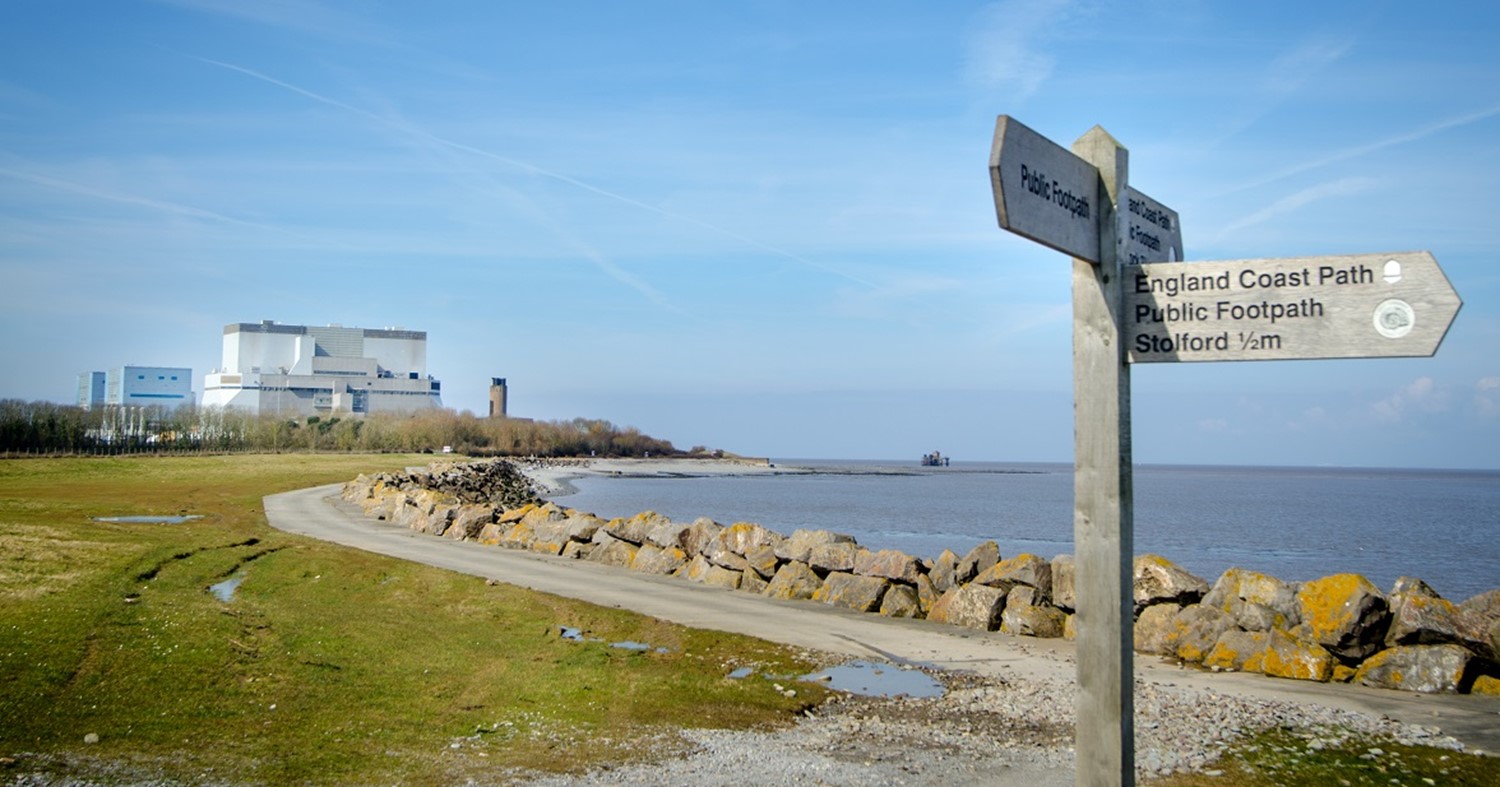Rendering of the proposed GEH Nuclear Energy BWRX-300 SMR at the Clinch River site. (Image: GE Hitachi)
The Tennessee Valley Authority and GE Hitachi Nuclear Energy (GEH) have signed an agreement to support planning and preliminary licensing for the potential deployment of a BWRX-300 small modular reactor at the Clinch River site near Oak Ridge, Tenn., the utility’s president and chief executive officer, Jeff Lyash, announced last week.
An evolution of GEH’s 1,520-MWe Generation III+ ESBWR design, the BWRX-300 is a 300-MWe water-cooled, natural-circulation SMR with passive safety systems.
The CANDU reactors at Qinshan. (Photo: Wikimedia/Atomic Energy of Canada Limited)
SNC-Lavalin subsidiary Candu Energy recently announced that it is engaged in pre-project design and engineering work at the Qinshan Phase III nuclear power station in China’s Zhejiang Province with Third Qinshan Nuclear Power Company (TQNPC), the plant’s operator.
EDF Energy’s Hinkley Point B nuclear power station, in Somerset, England. (Photo: EDF Energy)
By all accounts the most productive nuclear power plant in British history, Somerset’s Hinkley Point B station closed for good on August 1, with the shutdown of its B1 unit, a 485-MWe advanced gas-cooled reactor. (The plant’s B2 unit, a 480-MWe AGR, was shuttered early last month.)
The station employed around 500 staff and 250 contractors and contributed approximately £40 million (about $48.7 million) per year to the Somerset economy, according to EDF Energy, owner and operator of the United Kingdom’s power reactor fleet.
Pictured during a tour of the EBR-II site are, from left, Robert Boston, DOE-ID manager; Rep. Mike Simpson (R., Idaho); Secretary Granholm; Director Wagner; and Marianne Walck, INL deputy laboratory director for science and technology. (Photo: INL)
Energy Secretary Jennifer Granholm visited Idaho National Laboratory on August 3 to meet with INL staff, including director John Wagner, as she toured key research facilities on INL’s 890-square-mile site and the lab’s campus in Idaho Falls.
Unit 3 at the Vogtle site in July 2022. (Photo: Georgia Power)
The Nuclear Regulatory Commission has authorized Vogtle plant operator Southern Nuclear to load fuel and begin operation at Unit 3—the first reactor to reach this point in the agency’s combined license process. (Prior to 1989, reactors were licensed under a two-step process, requiring both a construction permit and an operating license.)
NIST's Center for Neutron Research in suburban Gaithersburg, Md. (Photo: NIST)
The Nuclear Regulatory Commission announced on August 2 that it had issued a confirmatory order to the National Institute of Standards and Technology (NIST) for violating NRC requirements during a February 2021 fuel failure at the 20-MWt NIST Center for Neutron Research (NCNR) research reactor in Gaithersburg, Md. NIST committed to improving its training for fuel handing procedures and related management activities, safety culture program, reactor facility operations staff and management, corrective action program and operational procedures, and emergency response resources and procedures, among other things.
Signing the letter of agreement, from the left, are Damian Jamroz, Last Energy Polska general manager; Ryszard Wawryniewicz, LSSE vice president; Piotr Danielski, DB Energy vice president; and Dominik Brach, DB Energy CEO. (Photo: LSSE)
Last Energy, a Washington, D.C.–based small modular reactor startup, has signed a letter of intent with Poland’s Legnica Special Economic Zone (LSSE) and DB Energy for a power plant featuring 10 small modular reactors with 200 MWe of capacity to fuel the region’s industrial activities. (Established in 1997, the LSSE covers 18 subzones located in the central part of southwestern Poland’s Dolnośląskie Province and is home to more than 75 companies providing some 16,000 jobs.)
America’s nuclear navy presently has 86 nuclear-powered submarines and aircraft carriers. All of them, and their predecessors over the last 60 years, have performed flawlessly, protecting America as well as their crews. Here, the nuclear submarine USS Seawolf leads the nuclear-powered aircraft carrier USS Nimitz and the conventionally powered Japan Maritime Self-Defense Force destroyer JS Oonami DD 111 during exercises in 2009. (Photo: United States Navy)
Just this last April, President Biden officially commissioned the USS Delaware, a new Virginia-class nuclear attack submarine, the 18th built in that class and the eighth and final Block III Virginia-class submarine. (The Delaware was administratively commissioned in April 2020, but the COVID-19 pandemic caused delay of the ceremony for two years.)
An artist's rendering of the NuScale plant. (Image: NuScale Power)
The Nuclear Regulatory Commission has directed its staff to issue a final rule certifying NuScale Power’s small modular reactor design for use in the United States, the agency announced last Friday.
Certification of the Portland, Ore.–based SMR developer’s design will become effective 30 days after publication of the rule in the Federal Register. The design will be incorporated as Appendix G to 10 CFR Part 52, Licenses, Certifications, and Approvals for Nuclear Power Plants.
An approach to future plant fabrication and siting suitable for many reactor types and scales, with large potential worldwide benefits
July 29, 2022, 3:25PMNuclear NewsMichael Golay, Jacopo Buongiorno, and Neil Todreas The offshore plant combines two mature technologies: the floating rig and the nuclear reactor.
In recent years, the rate of building new nuclear power plants has slowed internationally except in some rapidly developing countries. In Western countries that have considerable experience with nuclear power, completion of new projects on time and on budget has become more difficult. Shipyard-fabricated plants may offer a new direction for meeting international needs and responding to requirements for better cost control and safety. In this article we offer an overview of the floating nuclear power plant concept, including experience with it to date and its key engineering and strategic features, along with related uncertainties and needed conditions for future projects to be successful.
The U.S. Capitol. Photo: Wikimedia commons.
In a 243–187 vote, the House of Representatives yesterday passed the CHIPS and Science Act of 2022, a $280 billion economic competitiveness package aimed at bolstering U.S. semiconductor manufacturing, as well as scientific research and development, including nuclear energy R&D.
The new TRFS provides for automated adjustment of the direction of the DIII-D primary magnetic field. (Photos: GA and PPPL)
The DIII-D National Fusion Facility now boasts a unique automated system that allows for a quick reversal of the direction of its magnetic field, expanding the range of possible fusion experiments while reducing downtime. General Atomics, which operates the DIII-D for the Department of Energy’s Office of Science, announced the new Toroidal Field Reversing Switch (TFRS) on July 26.



















